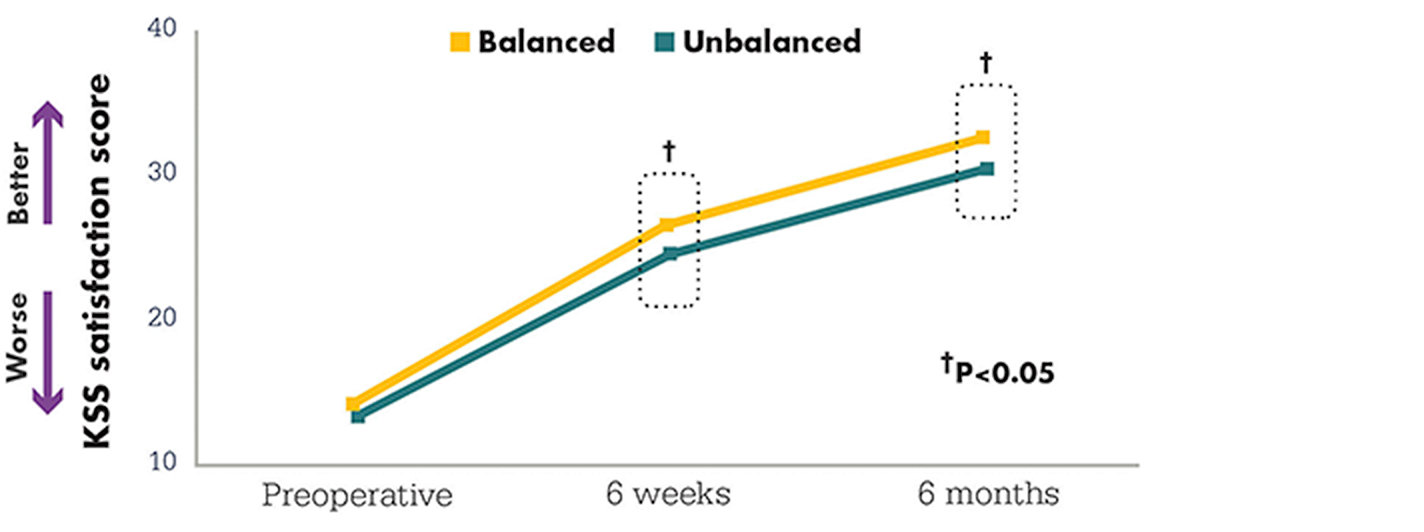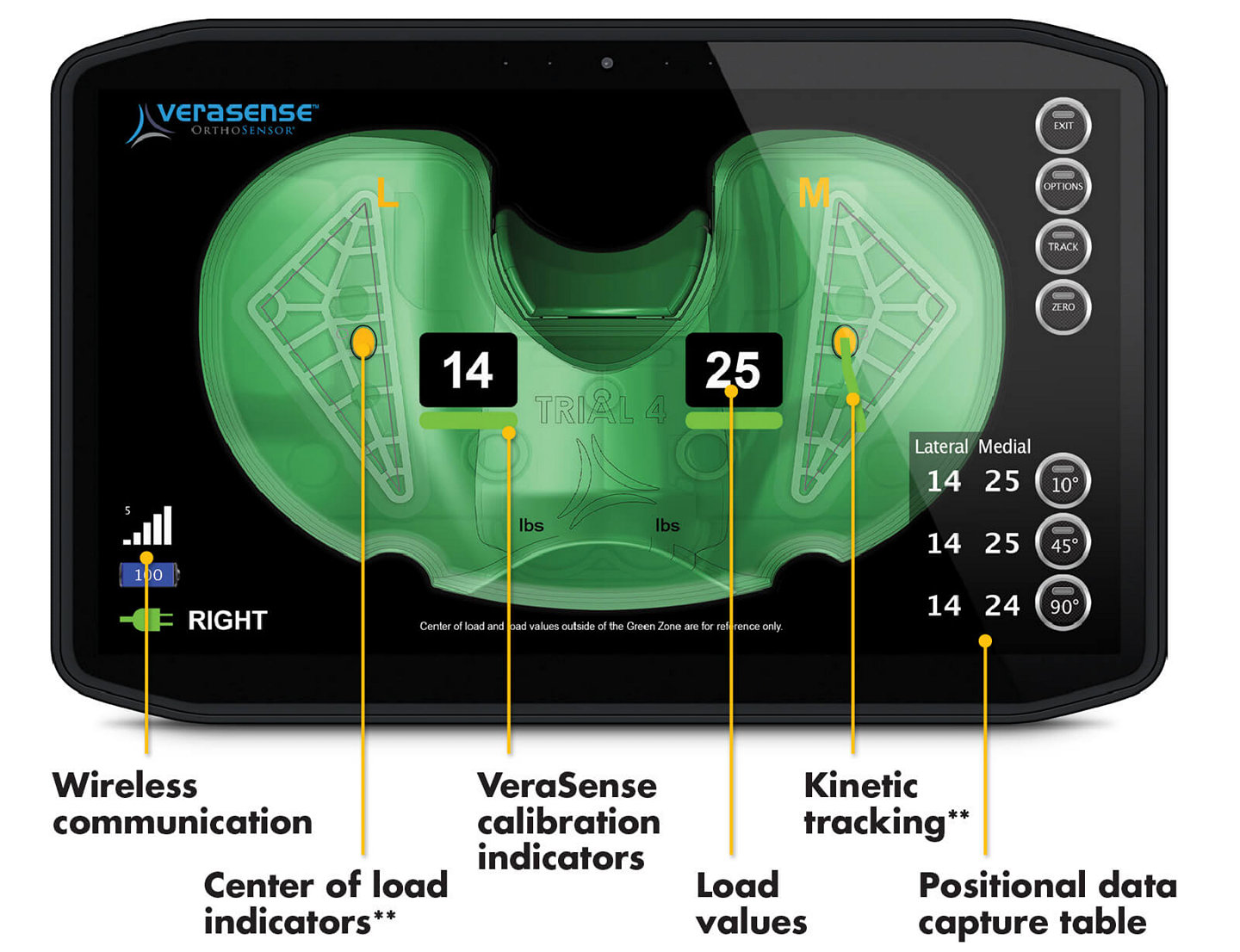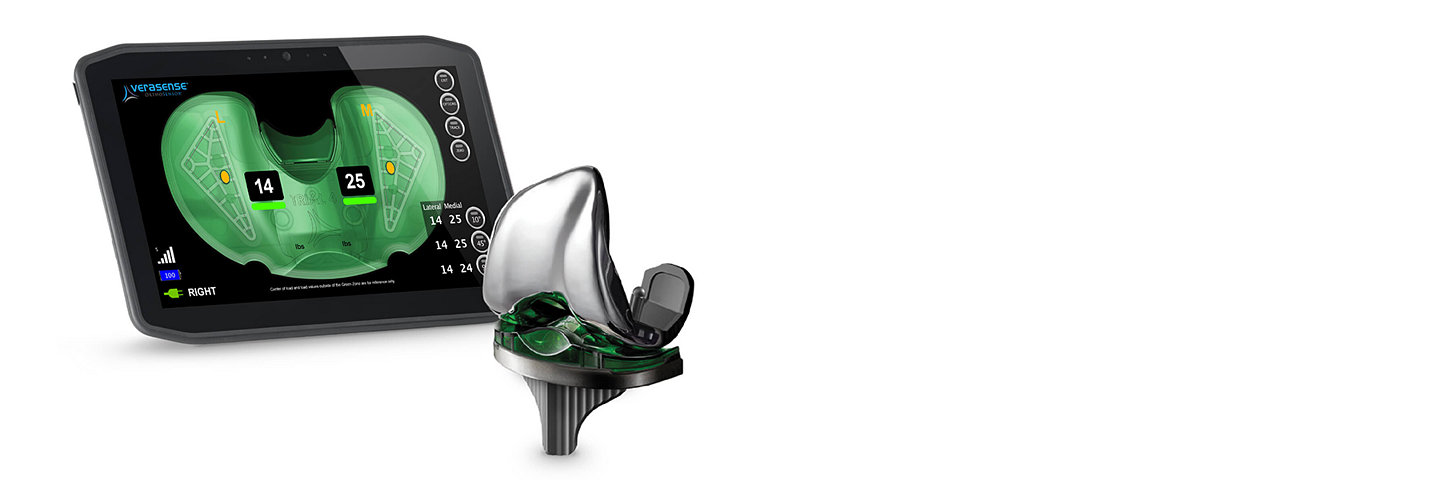
Imbalance of soft tissues and improper position of the knee implant can result in pain, stiffness, limited range of motion and instability in the knee. VeraSense sensor technology is a single-use instrument that delivers evidence-based data wirelessly to an intraoperative monitor, enabling surgeons to perform real-time, quantified soft tissue balancing and implant positioning during total knee arthroplasty (TKA).
Key benefits
P=0.004
| Mean Score Change (pre-op to 6 months) | |||
| Manual | VeraSense | P-value | |
| KSS Pain | 29 | 36 | 0.001 |
| KSS Function | 23 | 27 | <0.001 |
| KSS Total | 52 | 63 | <0.001 |
| Oxford | 13 | 17 | 0.025 |

* This study utilized a non-Stryker VeraSense variant in reaching its conclusions. Outcomes may vary when using a Stryker variant.

Clinical and economic benefits of quantified balance
A knee that is not correctly balanced during total knee arthroplasty may result in pain, stiffness, limited function and range of motion and instability for the patient following surgery.5-9 These patient-reported outcome measurements can influence patient satisfaction and quality of care metrics for reimbursement.
The use of VeraSense has shown statistically significant improvements in patient-reported outcome measurements and increase in physical therapy performance during early post-op recovery and rehabilitation for TKA.2-5 These improvements have translated to shorter treatments and lower overall costs in the complete TKA episode of care.5
How VeraSense works
The VeraSense trial, which replaces the standard Triathlon tibial insert trial, can be used during the trialing and final implantation stages of TKA. It utilizes proprietary sensor technology to provide you the following real-time data:
- Dynamic medial and lateral compartmental loads, quantified in pounds-force (lbf)
- The location of the center of load in each compartment**
- Kinetic tracking of tibiofemoral articulation**
The VeraSense software displays this information on a tablet – the LinkStation MINI – via Bluetooth communication, allowing you to intraoperatively view and capture the compartmental loads at multiple degrees of flexion and assess joint kinetics throughout a range of motion.


**For reference only
VeraSense videos
VeraSense for Triathlon: Knee Balancing with Sensor Technology
Dr. Martin Roche and Dr. Kevin Wang discuss their experiences and outcomes using VeraSense for Triathlon, including details on how they critically analyze intraoperative VeraSense load data to address imbalances in commonly encountered balancing scenarios.
Try VeraSense Today
To learn more about VeraSense, contact your Stryker Joint Replacement Representative using the form belowReferences
- Dominic T. Mathis, Leif Lohrer, Felix Amsler, Michael T. Hirschmann. Reasons for failure in primary total knee arthroplasty - An analysis of prospectively collected registry data. Journal of Orthopaedics, 2021; 23: 60-66.
- Geller JA, Lakra A, Murtaugh T. The Use of Electronic Sensor Device to Augment Ligament Balancing Leads to a Lower Rate of Arthrofibrosis After Total Knee Arthroplasty. J Arthroplasty. 2017 May;32(5):1502-1504. doi: 10.1016/j.arth.2016.12.019
- Chow JC, Breslauer L. The Use of Intraoperative Sensors Significantly Increases the Patient-Reported Rate of Improvement in Primary Total Knee Arthroplasty. Orthopedics. 2017 Jul 1;40(4):e648-e651. doi: 10.3928/01477447-20170503-01
- Golladay GJ, Bradbury TL, Gordon AC, et al.Are patients more satisfied with a balanced total knee arthroplasty? J Arthroplasty. 2019;34(7S):S195-S200. doi:10.1016/j.arth.2019.03.036
- Conditt MA, Chow J, Gordon A, et al. Can a balanced TKA save money post-operatively? Presented at: 31st Annual Congress of the International Society for Technology in Arthroplasty (ISTA); October 10-13, 2018; London, UK
- Parratte S, Pagnano MW. Instability after total knee arthroplasty. J Bone Joint Surg Am 2008; 90: 184–94.
- Lombardi AV Jr1, Berend KR1, Adams JB1. Why knee replacements fail in 2013: patient, surgeon, or implant? Bone Joint J. 2014 Nov;96-B (11 Supple A):101-4.
- Bozic KJ, Kurtz SM, Lau E, Ong K, Chiu V, Vail TP, Rubash HE, Berry DJ. The epidemiology of revision total knee arthroplasty in the United States. Clin Orthop Relat Res.2010; 468(1):45–51.
- Rodriguez-Merchan, EC. Instability Following Total Knee Arthroplasty. HSS J. Oct 2011; 7(3): 273–278.
Disclaimer
A surgeon must always rely on his or her own professional clinical judgment when deciding whether to use a particular product when treating a particular patient. Stryker does not dispense medical advice and recommends that surgeons be trained in the use of any particular product before using it in surgery. The information presented is intended to demonstrate the breadth of Stryker’s product offerings. A surgeon must always refer to the package insert, product label and/or instructions for use before using any of Stryker’s products.
Products may not be available in all markets because product availability is subject to the regulatory and/or medical practices in individual markets. Please contact your sales representative if you have questions about the availability of products in your area. Stryker Corporation or its divisions or other corporate affiliated entities own, use or have applied for the following trademarks or service marks: Stryker, Triathlon, VeraSense. All other trademarks are trademarks of their respective owners or holders.
VERAS-WC-4_33228

